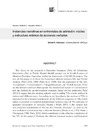Identificador persistente para citar o vincular este elemento:
https://accedacris.ulpgc.es/jspui/handle/10553/12248
| Campo DC | Valor | idioma |
|---|---|---|
| dc.contributor.author | Salmaso, Grisel S. | en_US |
| dc.date.accessioned | 2014-10-01T02:30:38Z | - |
| dc.date.accessioned | 2018-03-15T14:28:06Z | - |
| dc.date.available | 2014-10-01T02:30:38Z | - |
| dc.date.available | 2018-03-15T14:28:06Z | - |
| dc.date.issued | 2013 | en_US |
| dc.identifier.issn | 1133-1127 | en_US |
| dc.identifier.uri | https://accedacris.ulpgc.es/handle/10553/12248 | - |
| dc.description.abstract | The focus of my research is Narrative Instances (NIs) of Admission Interviews (AIs) in Public Mental Health carried out in Youth Centres of Mendoza Province, Argentina, within the framework of MOdEAS project. The aim of this paper is to show the functional relation between NIs and Verbal Actions (Paris 2012, 2009, Paris et al. 2008) that are expressed in the AIs: <complaint>, <victimisation>, <disqualification>, etc. Verbal Actions (VAs) are theoretical constructs that capture the interactional nature of conversations and are defined by an information structure based on five attributes. Paris (2012:3) argues that the abstract scheme used to define VAs can be realised in various and different ways. According to my hypothesis, the nucleus of VAs is expressed in the evaluative constituents of the different categories of NIs, which makes it possible to establish relationships between type of VA and type of appraisal (subsystem of attitude) (Martin y White 2005). I also sustain that non-evaluative constituents of NIs are the “rhetoric structure”, i.e. each of the non-evaluative constituents has a rhetoric function (Mann et al., 1992; Mann y Thompson, 1988; Paris, 2010) which contributes to the effective completion of the VA. In this paper, I illustrate the relation between nucleus and rhetorical structure of the VAs <complaint> (París 2012), <victimisation> and<disqualification> (Salmaso 2013) with a NI that belongs to the category Narrative. | en_US |
| dc.format | es | |
| dc.language | spa | en_US |
| dc.relation.ispartof | LFE. Revista de Lenguas para Fines Específicos | en_US |
| dc.source | LFE. Revista de Lenguas para Fines Específicos [ISSN 1133-1127], n. 19, p. 414-441 | en_US |
| dc.subject | 570107 Lengua y literatura | en_US |
| dc.subject | 550510 Filología | en_US |
| dc.subject.other | Narrative Instances (NIs) of Admission Interviews (AIs) | en_US |
| dc.subject.other | Public Mental Health | en_US |
| dc.title | Instancias narrativas en entrevistas de adminisión: núcleo y estructura retórica de Acciones Verbales | en_US |
| dc.type | info:eu-repo/semantics/article | en_US |
| dc.type | Article | en_US |
| dc.compliance.driver | 1 | es |
| dc.identifier.absysnet | 233536 | - |
| dc.description.lastpage | 441 | en_US |
| dc.description.firstpage | 414 | en_US |
| dc.investigacion | Artes y Humanidades | en_US |
| dc.rights.accessrights | info:eu-repo/semantics/openAccess | es |
| dc.type2 | Artículo | en_US |
| dc.utils.revision | Sí | en_US |
| dc.identifier.ulpgc | Sí | en_US |
| dc.description.esci | ESCI | |
| dc.description.dialnetimpact | 0,0 | |
| dc.description.dialnetq | Q2 | |
| dc.description.erihplus | ERIH PLUS | |
| item.fulltext | Con texto completo | - |
| item.grantfulltext | open | - |
| Colección: | LFE, Rev. leng. fines específ. n.19, 2013 Artículos | |
Visitas
107
actualizado el 14-dic-2024
Descargas
57
actualizado el 14-dic-2024
Google ScholarTM
Verifica
Comparte
Exporta metadatos
Los elementos en ULPGC accedaCRIS están protegidos por derechos de autor con todos los derechos reservados, a menos que se indique lo contrario.
